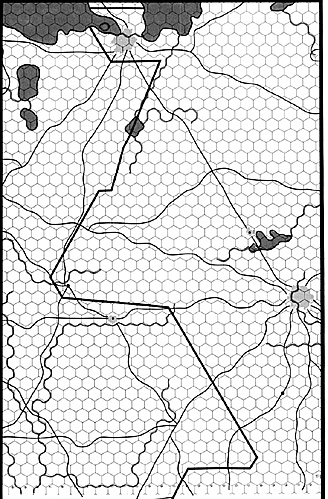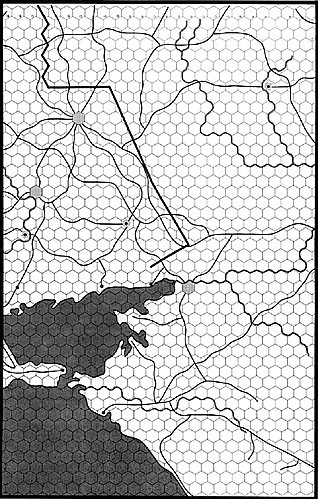This DNO/UNT scenario is designed to pick up the Eastern Front conflict at the opening of the Kursk Offensive and carry it through to the normal ending of the game, in February 1945. The scenario starts with the Kursk Offensive about to begin.
Pre-Game Set-up:
Before the game begins the front line must be designated on the map. The front line runs directly from center to center of the hexes listed below; any hex containing this line is a front line hex. Note that this is the German front line, and only the German player may set up in hexes containing this line. Check the diagram on the opposite page for the finished result.
Kuban Bridgehead (on map 4)
LL-40 to JJ-38
JJ-38 to HH-38
Front line (map 4)
X-29 to U-25
U-25 to P-25
P-25 to G-24
G-24 to G-29
G-29 to F-29
F-29 to E-28
E-28 to D-28
D-28 to C-27
C-27 to B-27
B-27 to A-26
A-26 to ZZ-26 (Map 2)
Map 2:
ZZ-26 to WW-50
WW-50 to VV-49
VV-49 to VV-44
VV-44 to UU-43
UU-43 to GG-43
GG-43 to FF-19 (map 1)
Map 1:
FF-19 to DD-19
DD-19 to V-11
V-11 to V-42 (map 2)
Map 2:
V-42 to R-38
R-38 to Q-37
Q-37 to J-3 2
J-32 to J-33
J-33 to J-36
J-36 to G-4 (map 1)
Finnish Front:
The Finnish front line extends along row E from the Gulf of Finland to Lake Lagoda (E-35 to E-31, map 3). The front line continues from Lake Lagoda along the northern bank of the Svir River.
Finnish front line (on map 5):
SS-27 to JJ-27
JJ-27 to HH-24
HH-24 to DD-24
DD-24 to BB-22
BB-22 to X-22
X-22 to M-11
Set-up procedures:
The German player sets up first. However, before he does so, the Russian player must secretly allocate all of his units into four regions. Region 1 consists of all of map 4 south of hex row 0. Region 2 contains everything south of hex row MM on map 2 ' not including region 1. Region 3 consists of everything north of hex row NN, map 2 and south of the "A" weather line, while Region 4 is everything north of the "A" weather line. After the German player has finished his initial set up, the Russian player may set up his units anywhere within the regions they were assigned to.
GERMAN ORDER OF BATTLE
Units available:
5 9-10 Panzer Divisions (9, 18, 12, 17, 27)
3 10-10 Panzer Divisions (3rd, 19th, 20th)
1 11-10 Panzer Division (11th)
2 12-10 Panzer Divisions (6th, 7th)
4 3-8 Panzer Kampfgruppen (1st, 4th, 8th, 22nd)
3 4-8 Panzer Kampfgruppen (2nd, 5th, 13th)
4 14-10 Panzergrenadier Divisions (1SS, 2SS, 3SS, 5SS)
1 12-10 Panzergrenadier Division (Grossdeutschland)
1 11-10 Panzergrenadier Division (11SS)
3 7-8 Motorized Divisions (14th, 18th, 25th)
1 6-8 Motorized Division (16th)
2 4-8 Motorized Kampfgruppen (10th, 20th)
1 3-8 Motorized KG (36th)
10 7-6 Infantry Divisions
76 6-6 Infantry Divisions
20 3-6 Infantry Kampfgruppen
8 5-6 Infantry Divisions
5 4-4 Static Divisions
1 3-4 Static Division
2 4-6 Security Divisions
6 3-6 Security Divisions
2 2-6 Security Divisions
4 6-8 Jaeger Divisions
4 5-8 Jaeger Divisions
3 6-8 Mountain Divisions
3 5-8 Mountain Divisions
1 4-8 Mountain Division
SS Troops:
1 6-8 Cavalry Division (8th)
1 6-8 Mountain Division (6th)
3 3-6 Infantry Brigades (Est., Lett., Wal.)
1 4-6 Infantry Brigade (Charl)
12 1-2-8 Police Regiments
1 0-1-6 Infantry Regt. (Dirl)
Luftwaffe Ground Troops:
8 4-5 Infantry Divisions
4 3-5 Infantry Divisions
4 3-10 Flak Regiments
21 1-10 Flak Battalions
Non-Divisional units-
3 0-1-10 Army Headquarters
6 0-1-6 An-ny Headquarters
13 2-1-6 Assault Gun Battalions
25 1-10 Anti-Tank
Battalions
5 1-8 Infantry Battalions
3 1-10 Engineer Battalions
6 1-8 Engineer Battalions
5 2-6 Engineer Battalions
20 0-1-6 Engineer Battalions
3 4-2-8 Tiger Tank Battalions
2 4-2-10 Panther Tank Battalions
Luftwaffe:
3 HS-129B
8 Ju-52
9 Ju-87G
8 Fw-190A
8 He-111H
15 Me-109G
12 Ju-88
2 Me-109F
2 Do-217
2 Me-109D
Other units:
25 Supply Factors
12 Airfields
35 Fortifications
22 Artillery units
23-0-0 Railroad Artillery units
12-0-0 Railroad Artillery unit
Twenty-two artillery units are selected at random from the 44 artillery units in the counter mix. The remainder are in the dead pile and can be rebuilt. The 3-1-4 artillery regiments scheduled to come in later are not included.
Units in dead pile (rebuildable):
10 7-6 Infantry Divisions
2 8-8 Motorized
Divisions
5 1-8 Infantry Battalions
1 3-10 Flak Regiment
5 1-10 Anti-Tank
Battalions
3 1-2-8 Machine Gun
Battalions
Rumanian Forces:
4 4-6 Infantry Divisions
3 2-3-4 Static Divisions
1 3-2 Static Division
1 4-8 Cavalry Division
1 3-4-10 Motorized Brigade
1 2-6 Engineer Regiment
1 1-6 Flak Battalion
1 1-6 Anti-Tank Battalion
1 SM-79
1 C-200
1 Me-109D
3 Replacement factors
Hungarian Forces:
7 4-6 Infantry Divisions
4 2-3-4 Static Divisions
1 3-8 Cavalry Brigade
1 2-10 Tank Brigade
1 1-6 Engineer Battalion
1 Me-109D
1 Ju-86
1 RE-2000
2 Replacement factors
Finnish Forces:
10 5-6 Infantry Divisions
2 4-6 Infantry Divisions
5 3-6 Infantry Divisions
1 2-8 Cavalry Brigade
3 2-8 Infantry Brigades
1 4-2-6 Artillery Regiment
1 1-6 Flak Battalion
1 1-6 Anti-Tank Battalion
4 0-8 Ski Battalions
5 Forts
5 Supply Factors
2 Airfields
3 Replacement factors
1 G-50
1 MS-406
1 F2A
1 MXD-T
1 Me-109E
All remaining Rumanian and Hungarian units in the counter mix are in the dead pile, and can be rebuilt. The Finns, however, are at their maximum strength, and may not rebuild in excess of their current size.
Deployment Limits:
1. All German and German Allied units must start on or west of the start line. Every hex in the front line must be occupied by a German unit or the zone of control of a German unit.
2. Static divisions, except those in the Rumanian and Hungarian army, must begin in a major city. Security divisions and police may not begin on the front line.
3. Seven German and seven Rumanian divisions must begin inside the Kuban Bridgehead (the area designated by the front line across the Straits of Azov). German divisions may be kampfgruppen.
4. The following units must begin north of the "A" weather line:
- 4 6-6Infantry Divisions
1 5-8Mountain Division
1 6-8Mountain Division
1 6-8SS Mountain Division
1 0-1-6Engineer Battalion
1 Airfield
5 Supply factors
5. The following units must begin within five hexes of Kharkov:
- 2 12-10 Panzer Divisions (6th, 7th)
1 11-10 Panzer Division (11th)
2 10-10 Panzer Divisions (3rd, 19th)
3 14-10 Panzergrenadier Divisions (1SS,2SS,3SS)
1 12-10 Panzergrenadier Division (GD)
2 6-8 Jaeger Divisions
4 7-6 Infantry Divisions
2 4-2-8 Tiger Tank Battalions
2 4-2-10 Panther Tank Battalions
3 1-8 Engineer Battalions
5 Artillery regiments
6. The following German units must begin within 5 hexes of hex TT-45, map 2:
- 2 9-10 Panzer Divisions(9th, 18th)
1 10-10 Panzer Division (20th)
1 14-10 Panzergrenadier Division (5SS)
3 7-6 Infantry Divisions
3 2-6 Engineer Battalions
3 Artillery Regiments
7. The 35 fortifications in the initial set-up must be placed on or within one hex of the start line.
RUSSIAN ORDER OF BATTLE
Units available:
1 15-9-8 Tank Corps (Guards)
1 14-9-8 Tank Corps (Guards)
3 13-8-8 Tank Corps
12 12-8-8 Tank Corps
1 18-8 Mechanized Corps (Gds.)
1 16-8 Mechanized Corps
2 15-8 Mechanized Corps
20 3-2-9 Tank Brigades
15 2-2-10 Tank Brigades
15 3-8 Mechanized Brigades
6 3-8 Assault Gun Brigades
1 3-8 Tank Brigade
(Guards)
1 15-4-9 Rocket Divisions
3 15-5-6 Artillery Divisions
1 12-6-7 Artillery Divisions (Gds.)
4 10-5-6 Artillery Divisions
4 9-5-7 Artillery Divisions
10 4-1-8 Rocket Regiments
20 3-2-4 Artillery Regiments
20 1-2-6 Anti-Tank Regiments
10 1-4 Anti-Aircraft Regiments
4 3-6-8 Anti-Aircraft Divisions
1 6-8 Cavalry Division (Gds.)
1 5-8 Cavalry Division (Gds.)
6 6-6 Infantry Divisions (Gds.)
8 5-6 Infantry Divisions (Gds.)
3 4-8 Cavalry Divisions
2 5-8 Cavalry Divisions
2 1-8 NKVD Regiments
9 2-5 Parachute Regiments
4 2-6 Ski Brigades
5 4-6 Mountain Divisions
1 3-6 Mountain Brigade
1 5-6 Engineer Division
2 3-6 Engineer Brigades
12 2-6 Engineer Regiments
20 1-6 Engineer Regiments
3 3-6 Marine Brigades
2 0-6 Mountain Division HQ
4 0-6 Infantry Division HQ
2 0-8 Army Headquarters
7 0-6 Army Headquarters
60 5-6 Infantry Divisions
160 4-6 Infantry Divisions
35 3-6 Infantry Brigades
20 2-6 Infantry Brigades
Russian Airforce:
18 Yak-7B
9 IL-4
9 Yak-9
3 A-20G
2 Yak-9D
9 Li-2
18 Lagg-5
4 P-39Q
25 IL-M3
2 Hurri-II
12 Pe-2
Other units:
15 Airfields
45 Supply factors
1 Battleship (in Kronstadt)
2 Heavy Cruisers (in Kronstadt)
4 Light Cruisers (in Black Sea)
12 2-4 Partisans
12 1-5 Partisans
24 0-6 Partisans
Units in dead pile:
3 12-8-8 Tank Corps
11 3-2-9 Tank Brigades
18 2-2-10 Tank Brigades
10 3-8 Mechanized Brigades
20 Cavalry factors
200 Infantry factors
Rules:
The scenario begins with the July I, 1943 turn. All of the standard DNO/ UNT rules are in effect, except when superceded by the following rules:
1. Neither player is required to maintain a continuous front line after the initial set-up. The German player, however, may not remove the units in the Kuban Bridehead until the Russian player advances and cuts off the Crimea. Each turn, the German player rolls one die: on a roll of one, the units are freed and may move normally.
2. All front-line Russian hexes in clear or rough terrain are considered to be fortified at the beginning of the game.
3. All Hungarian and Rumanian units must operate south of Brest. All Estonian and Lativian SS units must operate north of Minsk.
4. Finland and Rumania will not surrender due to the drop of unsupplied paratroopers alone. Rumania will not surrender because of sea invasion alone.
5. Any stack of Finnish units defending within 6 hexes of Helsinki receives a -1 modification on the die roll. Finnish Ski units are treated as Russian partisans.
6. On Sept. II, 1943, six German fighter units are removed for Reich defense.
7. German 6-6 and 7-6 infantry divisions are transformed into a 1-5 Kampfgruppe when destroyed, subject to the same rules regarding armor kampfgruppes.
8. The Russian player starts the game with 48 partisan units. These units must be placed behind the German lines. No more than two can start stacked in one hex, and no stack of partisans may be within 3 hexes of another.
9. When the Russian Army comes within 10 hexes of Warsaw, an uprising of the Poles in Warsaw is possible. Roll one die, and double the result; this is the number of Polish combat factors present in the city. These combat factors must immediately attack the German units in Warsaw, which are not doubled in the turn of the uprising. In the German phase, the German units must either attack or leave the city. Poles may never move from Warsaw.
Victory Conditions
The victory conditions are the same as in Unentschieden. The Germans begin the scenario with 7 points from the occupation of Ros.
Planning Maps


Back to Grenadier Number 1 Table of Contents
Back to Grenadier List of Issues
Back to MagWeb Master Magazine List
© Copyright 2000 by Pacific Rim Publishing
This article appears in MagWeb (Magazine Web) on the Internet World Wide Web. Other military history articles and gaming articles are available at http://www.magweb.com